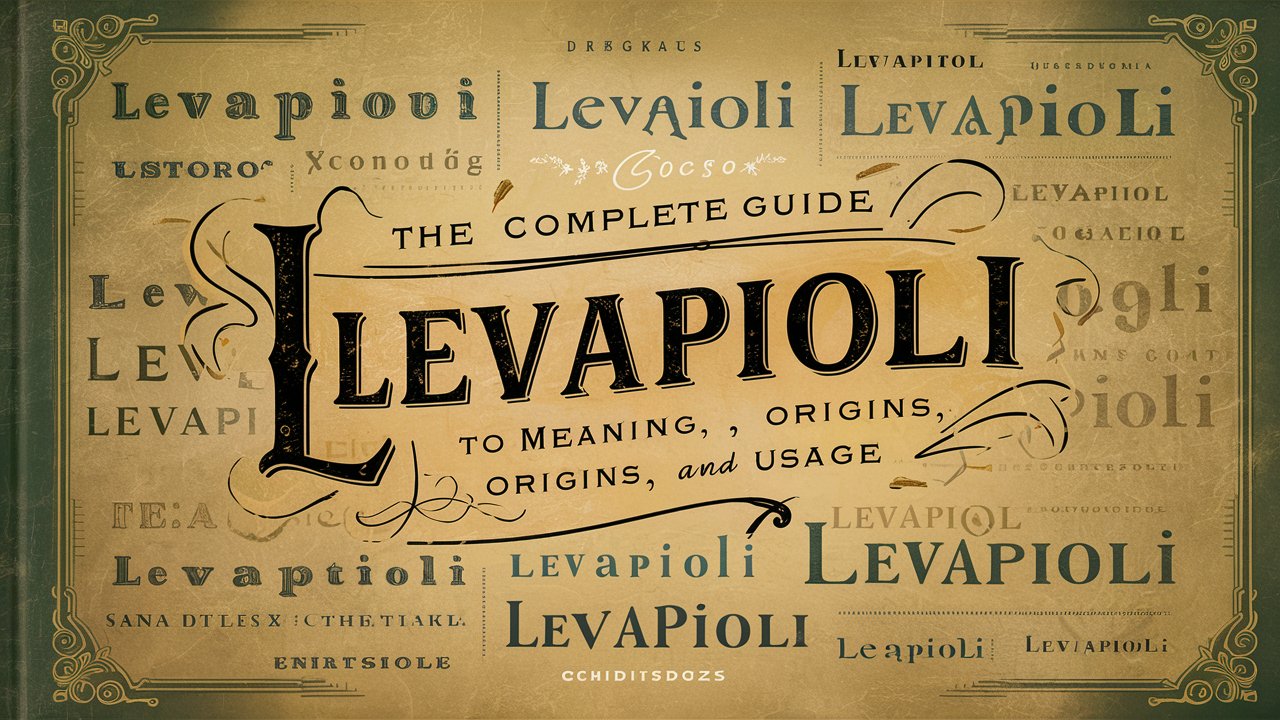Levapioli: The Complete Guide to Meaning, Origins, and Usage

In the world of unique terms and modern linguistic evolution, levapioli has gained attention as a keyword that sparks curiosity. Many individuals come across this word while browsing online, exploring cultural references, or diving into niche conversations, but few fully understand its background, significance, and real-life applications. This article aims to provide a comprehensive explanation of levapioli, covering its origins, contextual meanings, practical uses, and cultural significance.
By the end of this article, you will gain a deeper understanding of why levapioli is being discussed across different communities and how its usage has spread.
What Does Levapioli Mean?
The word levapioli does not belong to common English vocabulary. It appears to originate from Italian roots, where “leva” refers to lever, lifting, or raising, and “pioli” can mean rungs of a ladder or small steps. When combined, levapioli suggests the concept of “lifting the steps” or “raising rungs.”
This interpretation makes levapioli symbolic of progress, growth, and upward movement, whether in a personal, cultural, or professional context. It can represent the act of advancing steadily, step by step, and resonates with individuals striving for success or continuous improvement.
The Origins of Levapioli in Italian Culture
In Italian culture, language often carries rich symbolic undertones. The term levapioli is rarely used in everyday conversation but can be found in older texts and idiomatic expressions, particularly in regional dialects. The imagery of a ladder and its rungs fits perfectly into the Italian tradition of metaphors related to ambition, craftsmanship, and life journeys.
Historically, Italian artisans, builders, and even farmers would refer to pioli (rungs) as essential tools in their daily lives. To “lift the rungs” or levare i pioli could metaphorically mean removing the steps, symbolizing either a challenge in climbing higher or an intentional act of preventing access. In a modern sense, levapioli captures both sides of this metaphor—progress when steps are available, or barriers when they are removed.
Levapioli as a Symbol of Progress and Growth
One of the most powerful ways to understand levapioli is through the lens of personal development. Just as a ladder is climbed one rung at a time, life itself demands persistence, effort, and the ability to rise above obstacles.
When interpreted as “lifting the rungs,” levapioli can symbolize the act of providing opportunities and making it possible for others to move forward. For instance, leaders who mentor their teams can be seen as practicing levapioli, as they create steps for others to climb toward success. Conversely, when someone removes the rungs, it can symbolize restricting progress, a concept often referenced in socio-political discussions about access, privilege, and fairness.
Practical Applications of Levapioli
While levapioli might seem abstract, it has real-world applications across several areas:
1. In Leadership and Management
Leaders often engage in levapioli by building structures, strategies, and opportunities for employees to advance. A manager who provides training programs, career pathways, or mentorship is effectively “adding rungs to the ladder” of success for their team.
2. In Education
Teachers and mentors play a critical role in levapioli. By equipping students with knowledge, they raise the ladder of growth, enabling learners to climb toward higher achievements.

3. In Self-Development
Individuals practicing levapioli in their own lives focus on goal setting, continuous learning, and resilience. Each achievement becomes a new rung in their personal ladder.
4. In Social Structures
The term also applies to discussions about equity and accessibility. Providing resources, removing barriers, and creating inclusive policies are all acts of levapioli, helping communities climb toward collective prosperity.
The Metaphorical Power of Levapioli in Literature and Philosophy
Writers and thinkers often use ladder metaphors to represent human ambition, growth, or spiritual journeys. The concept of levapioli fits seamlessly into this tradition. Philosophers could interpret it as a metaphor for removing obstacles on the path of enlightenment, while novelists may use it to describe the struggle of characters climbing toward dreams despite adversity.
In modern motivational writing, levapioli can be a powerful reminder that progress is never achieved in one leap, but through a series of steps.
Cultural Interpretations of Levapioli Across Borders
While its roots may be Italian, the idea behind levapioli resonates universally. In Eastern philosophies, the notion of gradual steps aligns with mindfulness and the path to enlightenment. In Western culture, particularly in business and entrepreneurship, the concept is evident in the idea of climbing the corporate ladder.
This cross-cultural adaptability gives levapioli a unique place as a concept that transcends language barriers, offering value to personal growth, leadership, and social development discussions worldwide.
Levapioli in Modern Digital Contexts
In today’s digital age, levapioli has started appearing in online forums, social media, and creative communities. People use it as a symbolic keyword to represent growth, achievement, or the act of helping others move upward. Hashtags, blog articles, and motivational posts often include similar metaphors of ladders, and levapioli fits perfectly into this trend.
For entrepreneurs and influencers, using levapioli in their branding or content strategies signals commitment to progress, empowerment, and guidance.
How to Apply Levapioli in Daily Life
To embrace the spirit of levapioli, individuals and organizations can take intentional actions:
-
Set clear goals and break them into achievable steps.
-
Support others by creating opportunities for growth.
-
Remove barriers that prevent people from reaching their potential.
-
Celebrate progress at every stage, recognizing each rung climbed.
-
Stay resilient, understanding that ladders may shift, but persistence ensures upward movement.
By incorporating levapioli into daily practices, one creates an environment where growth and progress are natural outcomes.
Conclusion
The term levapioli may be unfamiliar to many, but its meaning, symbolism, and cultural depth make it a powerful concept worth exploring. Rooted in the imagery of ladders and rungs, it represents growth, progress, opportunity, and resilience. Whether applied to leadership, education, personal development, or cultural discussions, levapioli inspires us to reflect on the steps we build for ourselves and others.
By understanding and practicing levapioli, we embrace a mindset of continuous upward movement, ensuring that every rung we add becomes a foundation for greater achievements ahead.
FAQ About Levapioli
Q1: Is levapioli a common word in Italian?
No, levapioli is not commonly used in everyday Italian. It has roots in the Italian language but is more symbolic than practical.
Q2: Does levapioli only apply to personal growth?
Not at all. Levapioli can be applied to leadership, education, social structures, and even literature or philosophy.
Q3: Can levapioli have a negative meaning?
Yes. If interpreted as removing rungs from the ladder, it can symbolize restricting opportunities or preventing growth.
Q4: How can I use levapioli in daily life?
By focusing on incremental progress, supporting others, and breaking down barriers, you can embody the principles of levapioli in everyday actions.
Q5: Why is levapioli gaining attention today?
Because it symbolizes universal values of growth, opportunity, and resilience, which resonate strongly in personal development, business, and cultural conversations.



